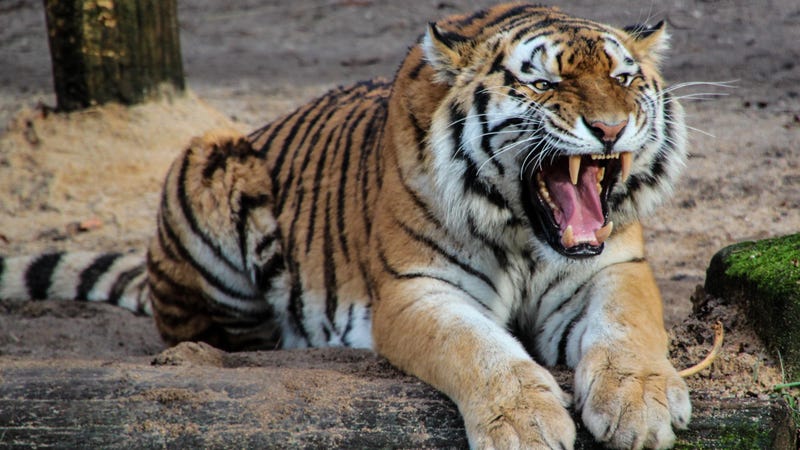
It’s rare to see them in the wild, but endangered animals are everywhere. Maybe Tony the Tiger reminded you that Frosted Flakes are great from the front of a cereal box, or that smiling polar bear caught your eye in a recent Coca Cola ad. Whatever your politics, the GOP’s elephant is ubiquitous, and when you queue up an MGM movie, a lion roars at you before the opening credits roll.
These are among the most widely represented animals in western culture, according to a recent study, which found we see up to 31 plush, cartoon, filmed, toy, and virtual representations of our ten favorite animals every week. In order, those animals are: the tiger, lion, elephant, giraffe, leopard, panda, cheetah, polar bear, grey wolf, and gorilla. But despite our apparent love for these “charismatic megafauna,” all of them are, in the words of the study, at “high risk of imminent extinction in the wild.”
And most people don’t even realize it. In surveys of the general public and college students, the study found more than half of over 4,500 people polled didn’t know that these animals were endangered.
All that PR—use in brands, wildlife specials, stuffed animals, and the bottomless well of children’s sympathy and love—hasn’t seemed to help. In fact, the researchers hypothesize that the attention has done these animals more harm than good. That’s because, as they write in the paper, “The public perception of the conservation status of these species appears to reflect virtual populations rather than real ones.” We see these animals so frequently, perhaps we assume them to be more abundant than they are.
“People see on average two to three times as many ‘virtual’ lions in a single year than the total population of wild lions currently living in the whole of West Africa,” Franck Courchamp, Director of Research at the CNRS at the University of Paris-Sud and the lead author of the study, told Earther. In his view, the discrepancy between virtual abundance and actual abundance is contributing to animals’ decline in direct ways.
“The creatures that we love the most are also the most likely to be hung on our walls, and used for medicine,” precisely because of how much social cache they have, Courchamp said. “One interesting observation is that direct killing—poaching, trophy hunting, and traditional medicine uses—constitutes one of the principal causes of endangerment for these animals.”
Courchamp thinks that in order for charismatic animals to actually benefit from all the publicity they’re getting, companies should pay to use them in marketing.
“Since those companies (unknowingly) contribute to making a biased perception, they should compensate for it by funding information campaigns or conservation directly,” he said, citing as an example Lacoste, which recently replaced its iconic crocodile with endangered species as part of a new conservation campaign.
But some conservationists think we should look deeper to understand what’s really behind our failure to protect charismatic animals before advocating solutions. After all, the study didn’t set out to evaluate why these animals are doing so poorly.
“This is an idea that should be evaluated by formal studies in the future,” conservation biologist David Steen told Earther in a Twitter direct message. He suggested there are other interpretations of the authors’ findings. “For example, it is possible that most people generally do not appreciate the conservation status of animals, regardless of how charismatic they are,” wrote Steen.
Conservationist and National Geographic Explorer Asher Jay thought the study might be overselling how much attention charismatic megafauna are really getting.
“We do not market any biodiversity, not even iconic megafauna, half as well as we do high fashion, shoes, or even household appliances,” Jay told Earther. “Think of how often you see something as banal as a soda pop commercial. How often are you reminded by the brand to consume it? That is what wild needs.”
Sylvia Fallon, director of the Wildlife Conservation project at the National Resources Defense Council pointed out that while public support can be “very effective” at making change, “it’s not the only factor determining successful species conservation.”
Stopping overexploitation and poaching is important, but no animal lives in a vacuum. Fallon says there’s also the much-thornier issue of saving habitats and ecosystems that our favorite animals need to survive, especially when those habitats “span multiple political boundaries” and are threatened by both human expansion and climate change.
Courchamp agrees on this point. “It’s important to realize that the species are important, but also that they are interconnected. It’s not just the tiger, it’s the whole ecosystem.”
So, maybe if brands actually want to effect change, they could try replacing their tigers and polar bears with melting glaciers and vanishing rainforests?
As a kid, Starre Vartan argued with her teachers that both science and art were creative endeavors; after 15 years as a science and environment reporter and creative writer, she still thinks that’s true.
.png)

No comments:
Post a Comment